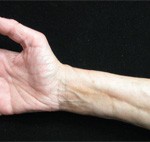D. Necrobiosis lipoidica (diabeticorum) (NLD): NLD is a disorder of collagen degeneration associated with diabetes, but it can occur in the absence of underlying diabetes. This diagnosis would distinguish itself over time. Lesions begin with erythema and tend to occur more frequently on the lower extremities. They evolve into shiny, somewhat atrophic yellowish plaques, which may ulcerate. This is different than the fibrotic, bound-down appearance of lipodermatosclerosis seen in our patient.
E. Limited systemic sclerosis: The asymmetric nature of the lesion, its characteristic location, and absence of other systemic signs and symptoms make this diagnosis much less likely, although a patient with limited systemic sclerosis has been described who developed LDS.1
Sources:
- Miteva M, Romanelli P, Kirsner RS. Lipodermatosclerosis. Dermatol Ther. 2010;23:375-388.
- Burnand K, Clemenson G, Morland M, Jarrett PE, Browse NL. Venous lipodermatosclerosis: Treatment by fibrinolytic enhancement and elastic compression. BMJ. 1980;280:7-11.
- Dakovic Z, Vesic S, Vukovic J, Medenica LJ, Pavlovic MD. Acute lipodermatosclerosis: An open clinical trial of stanozolol in patients unable to sustain compression therapy. Dermatol Online J. 2008;14:1

Dr. Merola is an instructor in the Department of Dermatology at Harvard Medical School and a fellow in the rheumatology division at Brigham and Women’s Hospital, both in Boston. He is the assistant program director for the Combined Medicine-Dermatology training program and a diplomat of the American Board of Dermatology and the American Board of Internal Medicine.


